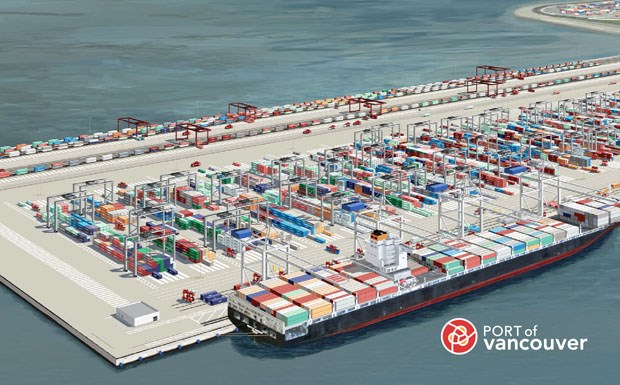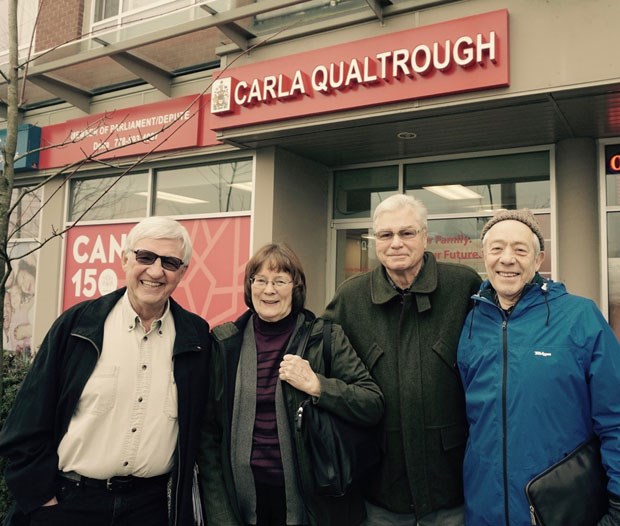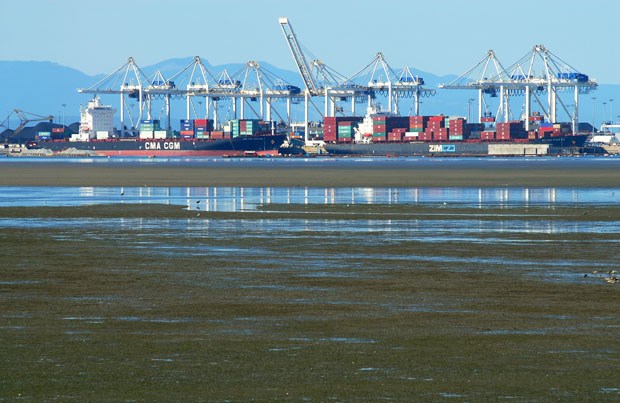The arguments will only intensify as those on both sides of a proposal to build one of the largest projects in Delta’s history will get a chance to have their say at an upcoming public hearing.
The independent federal review panel gathering information and feedback on the Port of Vancouver’s Terminal 2 application will finally hold a hearing this spring on the plan to build a three-berth container terminal on a man-made island at Roberts Bank adjacent to the existing Deltaport container terminal.
According to the Vancouver Fraser Port Authority’s stats for 2018, container volume, measured in 20-foot equivalent units (TEUs), increased by 4.4 per cent to a record 3.4 million TEUs. Even with additional capacity provided by facility improvements, forecasts by independent experts show it won’t be enough to manage Canada’s future demand, according to the port authority, noting it highlights the need for T2.

“The picture is all across the board. We have the major terminals (Deltaport, Vanterm, Centerm and Fraser Surrey Docks) and they’re all seeing strong volumes. In fact, close to capacity, so it’s really just underlining the importance of continuing to deliver capacity to accommodate Canadian growth in containers,” port president and CEO Robin Silvester told the Optimist.
Noting the port submitted its project description in 2013 to begin the review process, Silvester said the proposal has gone through the most thorough Canadian environmental assessment process possible. The independent review panel has told the port on several occasions to submit additional information, but that has now wrapped up with the panel deciding it received everything it needs to begin the public hearing process.
“That’s a really significant milestone… we’re finally there. I don’t know if we’ve reached the start line or gone into the stadium, but we’re at the stage now where the public hearing is ready to go,” said Silvester.
The port authority notes that since it provided an estimate on the number of ships expected as a result of the project, there have been developments in the container shipping industry, such as an accelerated trend toward larger ships and the overbuilding of shipping capacity, which has led to the demise of some shipping companies and the formation of new service alliances among others.
As a result, the port authority commissioned a study to provide new estimates about the number of ships expected as a result of T2.
“The total number of container ships that serve Port of Vancouver container terminals will be the same, whether or not Roberts Bank Terminal 2 is built. What will change is the size of the ships, which will be slightly larger on average if the project proceeds, and the amount of cargo loaded and unloaded in Vancouver, which will increase by approximately 33 per cent,” the port explains.

“As a result of industry shipping trends, the 2018 study forecasts fewer overall ship calls to the Port of Vancouver in 2035 than there were in 2017, with or without Roberts Bank Terminal 2, despite an increase in container volumes. This is a continuation of the trend of declining container ship calls and larger ships at the Port of Vancouver since around 2005… If Roberts Bank Terminal 2 is not built, increasing import demand for container cargo by Canadians will go through U.S. ports. This would result in higher costs, higher transportation emissions and unrealized economic opportunity, including jobs for Canadians.”
Port officials Cliff Stewart and Tom Corsie recently made a presentation to Delta council to explain the rationale for T2, noting that planned improvements are underway within their port facilities and at the Port of Prince Rupert won’t be able to accommodate future demand.
The port authority investigated the potential of converting other terminals within its jurisdiction to handle containers. Terminal operators at the Port of Vancouver operate under long-term renewable lease agreements with the Vancouver Fraser Port Authority and have made significant investments in equipment and infrastructure, so the opportunities to convert a terminal to handle containers are restricted.
“Ultimately, we cannot arbitrarily direct a terminal operator to change its business, and in this case, none were deemed suitable. We also determined that terminals on the Fraser River cannot accommodate today’s large container vessels because they cannot safely navigate the river. Further, road connections to terminals on the north shore of Burrard Inlet are not adequate to handle container trucking volumes,” according to the port.
Most of the T2 project, which would come with associated road and rail improvements, would be constructed on submerged federal lands managed by the port. A portion would be constructed on provincial Crown lands which the province has already approved transferring. That got some groups like BC Nature upset, saying it suggests provincial compliance and approval of T2 prior to the completion of the environmental assessment.
“You are presumably aware that the area where this man-made island would be built is one of the most significant Important Bird Areas in the whole of North America. It is identified as a Western Hemisphere Shorebird Reserve whose wetlands are critical for the survival of millions of shorebirds,” BC Nature president Alan Burger wrote to Transportation Minister Claire Trevena in 2017.
For several years the port conducted field studies at Roberts Bank and the surrounding areas that built on previous scientific work. The results of the studies were part of the project’s environmental impact statement, which includes proposed mitigation measures to reduce, avoid or offset potential effects and describe the monitoring and follow-up program that would be undertaken to ensure mitigation measures are effective.
“The environmental impact statement and Marine Shipping Supplemental Report conclude that the project should be approved to proceed, given that it is not likely to cause significant adverse environmental effects, and given the benefits of the project to Canada and British Columbia,” the port states.
However, groups Against Port Expansion (APE) and Citizens Against Port Expansion (CAPE) say that’s not so, joined by others who say the environmental impacts will be devastating.

“The project will harm the fragile estuary with habitat loss and destruction, as well as noise, light, water and air pollution. The losses cannot be effectively mitigated,” APE states.
Among their arguments against the project is the submission last year by Environment and Climate Change Canada to the review panel. That submission disagreed with the port’s conclusion the project would result in no residual effects to coastal birds.
The agency also outlined concerns with the proposed offset plan to mitigate the direct loss of wetlands, including mudflats which contain the food source biofilm, noting most of the reliable evidence in the port’s environmental impact statement indicated the potential for large declines in food availability for shorebirds during the critical breeding migration period.
“ECCC maintains that there is insufficient, science-based information to support the proponent’s finding that the project would not adversely impact intertidal biofilm and, consequently, migratory shorebirds in general, and the western sandpiper species in particular,” the ECCC submission states.
As far as the business case, APE’s Roger Emsley said, “The Port of Vancouver continues to mislead. It has missed every one of its most recent forecasts. With the planned expansions at Vancouver container terminals plus the potential for Prince Rupert’s container terminal to grow into a four- to five-million TEU terminal, West Coast Canada will have plenty of capacity for Canada’s trading needs for the foreseeable future without ever building RBT2. Furthermore. Prince Rupert expansion can be built at less than half the cost of RBT2,” he said.
“VFPA continues to downplay and try to ignore Prince Rupert, making misleading comments to the effect that even with that expansion RBT2 is still needed. At a four- to five-million TEU facility Prince Rupert obviates the need to build RBT2. Furthermore, PR is two sailing days closer to Asia and does not have the environmental issues that Roberts Bank has. In addition, its rail route to the east is much better than the route through the Fraser Canyon that VFPA must use.”
Also raising questions about the port’s business case is Global Container Terminals, the container terminal operator at Deltaport, which wasn’t allowed to bid on operating T2. GCT says it “has first-hand knowledge of the significant negative impact on business growth and investment caused by overcapacity” through its experience in the ports of New York and New Jersey.
The environmental review panel will begin its public hearing in Delta on May 14. The hearing will be open to the public to observe in person or via a live webcast and/or audiocast. For more information about the hearing or how to participate, check https://ceaa-acee.gc.ca/050/evaluations/document/126873?culture=en-CA.



